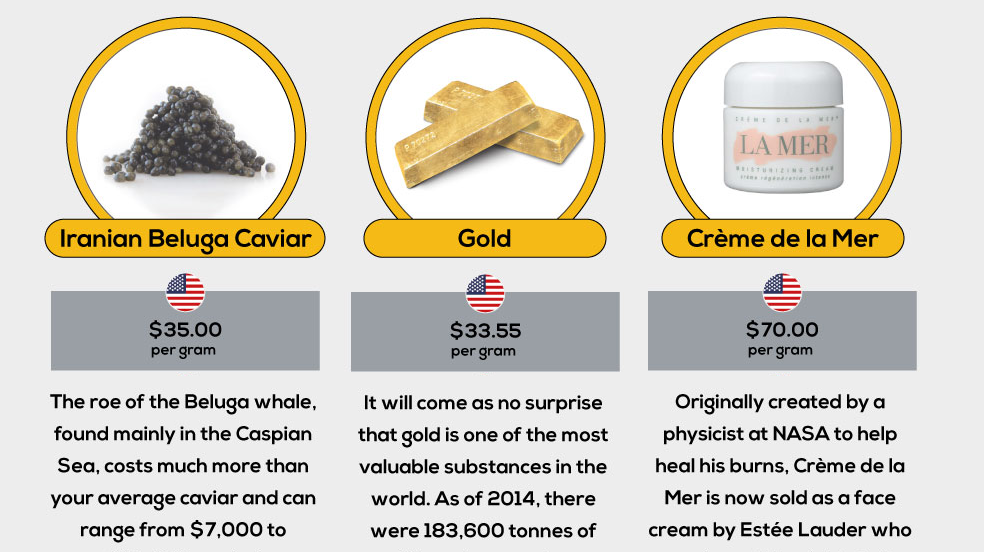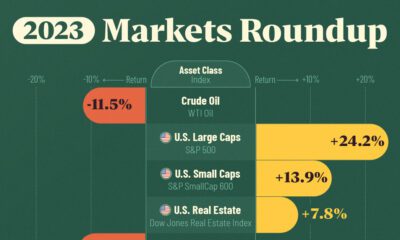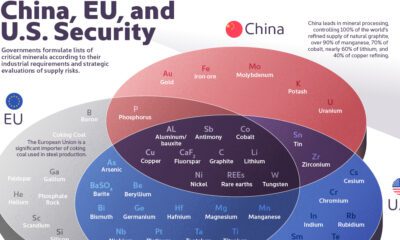Mining
The World’s Most Valuable Substances by Weight

The World’s Most Valuable Substances by Weight
In the field of economics, the laws of supply and demand state that the price of a product and its available supply to the market are interconnected. For example, if a good such as crude oil is produced in excess, the price will drop accordingly.
However, sometimes substances are nearly impossible to produce in the first place – and that means that it can be extremely difficult for the market to respond to increases in demand. The world’s most valuable substances generally fall into this category, and this makes their value per gram very high.
White truffles, for instance, only grow for a couple of months of the year almost exclusively from one part of Italy. They must be foraged by special pigs, and they seem to be worth more every year. The price per gram for white truffles is $5, which means that a pound costs close to $2,000.
Despite this, white truffles barely crack the list of the most valuable substances by weight.
Saffron, a spice that is gathered from the flower of the crocus sativus plant, is another notch higher on the spectrum. To get one pound of dry saffron requires the harvest of 50,000 to 75,000 flowers. There’s only 300 tonnes of production each year, and that annual production is worth around $3 billion.
Higher up on the list of the world’s most valuable substances are some familiar metals. Silver does not make the list, as it is only worth around $0.50 per gram. However, many of the platinum group metals (PGMs) do make the list: platinum, palladium, rhodium, and iridium all range between $16 to $27 per gram. Gold also makes the list, and it has traded for more than an ounce of platinum since early 2015. One gram of gold is worth just under $34 per gram.
At the top of the list we find a combination of extremely rare metals, radioactive isotopes, and gemstones.
The radioactive element Californium, first made in 1950, is the most valuable at $27 million per gram. It is one of the few transuranium elements that have practical applications, being used in microscopic amounts for metal detectors and in identifying oil and water layers in oil wells.
Diamonds are near the top of the list as well at $65,000 per gram, though like many other gemstones, the value depends on the specific crystal in question. Many industrial diamonds are relatively cheap, but the rarest and most beautiful stones can be worth millions.
Iranian beluga caviar and Crème de la Mer are the most expensive non-metals or non-gemstones on the list. Iranian caviar is made from the roe of beluga sturgeons found in the Caspian Sea, and it is valued at about $35 per gram. Crème de la Mer was originally created by a physicist for NASA to heal his burns, but it is now sold as a face cream by Estée Lauder for $70 per gram.
Original graphic by: BullionVault
Lithium
Ranked: The Top 10 EV Battery Manufacturers in 2023
Asia dominates this ranking of the world’s largest EV battery manufacturers in 2023.

The Top 10 EV Battery Manufacturers in 2023
This was originally posted on our Voronoi app. Download the app for free on iOS or Android and discover incredible data-driven charts from a variety of trusted sources.
Despite efforts from the U.S. and EU to secure local domestic supply, all major EV battery manufacturers remain based in Asia.
In this graphic we rank the top 10 EV battery manufacturers by total battery deployment (measured in megawatt-hours) in 2023. The data is from EV Volumes.
Chinese Dominance
Contemporary Amperex Technology Co. Limited (CATL) has swiftly risen in less than a decade to claim the title of the largest global battery group.
The Chinese company now has a 34% share of the market and supplies batteries to a range of made-in-China vehicles, including the Tesla Model Y, SAIC’s MG4/Mulan, and various Li Auto models.
| Company | Country | 2023 Production (megawatt-hour) | Share of Total Production |
|---|---|---|---|
| CATL | 🇨🇳 China | 242,700 | 34% |
| BYD | 🇨🇳 China | 115,917 | 16% |
| LG Energy Solution | 🇰🇷 Korea | 108,487 | 15% |
| Panasonic | 🇯🇵 Japan | 56,560 | 8% |
| SK On | 🇰🇷 Korea | 40,711 | 6% |
| Samsung SDI | 🇰🇷 Korea | 35,703 | 5% |
| CALB | 🇨🇳 China | 23,493 | 3% |
| Farasis Energy | 🇨🇳 China | 16,527 | 2% |
| Envision AESC | 🇨🇳 China | 8,342 | 1% |
| Sunwoda | 🇨🇳 China | 6,979 | 1% |
| Other | - | 56,040 | 8% |
In 2023, BYD surpassed LG Energy Solution to claim second place. This was driven by demand from its own models and growth in third-party deals, including providing batteries for the made-in-Germany Tesla Model Y, Toyota bZ3, Changan UNI-V, Venucia V-Online, as well as several Haval and FAW models.
The top three battery makers (CATL, BYD, LG) collectively account for two-thirds (66%) of total battery deployment.
Once a leader in the EV battery business, Panasonic now holds the fourth position with an 8% market share, down from 9% last year. With its main client, Tesla, now sourcing batteries from multiple suppliers, the Japanese battery maker seems to be losing its competitive edge in the industry.
Overall, the global EV battery market size is projected to grow from $49 billion in 2022 to $98 billion by 2029, according to Fortune Business Insights.
-

 Mining1 week ago
Mining1 week agoGold vs. S&P 500: Which Has Grown More Over Five Years?
-

 Markets2 weeks ago
Markets2 weeks agoRanked: The Most Valuable Housing Markets in America
-

 Money2 weeks ago
Money2 weeks agoWhich States Have the Highest Minimum Wage in America?
-

 AI2 weeks ago
AI2 weeks agoRanked: Semiconductor Companies by Industry Revenue Share
-

 Markets2 weeks ago
Markets2 weeks agoRanked: The World’s Top Flight Routes, by Revenue
-

 Countries2 weeks ago
Countries2 weeks agoPopulation Projections: The World’s 6 Largest Countries in 2075
-

 Markets2 weeks ago
Markets2 weeks agoThe Top 10 States by Real GDP Growth in 2023
-

 Demographics2 weeks ago
Demographics2 weeks agoThe Smallest Gender Wage Gaps in OECD Countries











